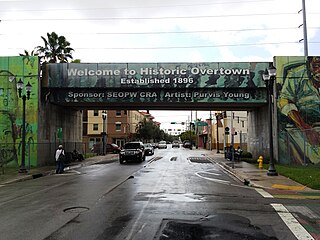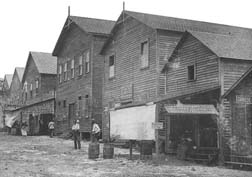Related Research Articles
In the broader context of racism against Black Americans and racism in the United States, mass racial violence in the United States consists of ethnic conflicts and race riots, along with such events as:
The 2001 Cincinnati riots were a series of civil disorders which took place in and around the Over-the-Rhine neighborhood of downtown Cincinnati, Ohio from April 9 to 13, 2001. They began with a peaceful protest in the heart of the city on Fountain Square over the inadequate police response to the police shooting of unarmed African American 19-year-old Timothy Thomas. The peaceful protest soon turned into a march that went in the direction of the victim's home neighborhood of Over-the-Rhine.

The 1992 Los Angeles riots, were a series of riots and civil disturbances that occurred in Los Angeles County, California, United States, during April and May 1992. Unrest began in South Central Los Angeles on April 29, after a jury acquitted four officers of the Los Angeles Police Department (LAPD) charged with using excessive force in the arrest and beating of Rodney King. The incident had been videotaped by George Holliday, who was a bystander to the incident, and was heavily broadcast in news and media outlets.
The 1991 Washington, D.C., riot, sometimes referred to as the Mount Pleasant riot or Mount Pleasant Disturbance, occurred in May 1991, when rioting broke out in the Mount Pleasant neighborhood of Washington, D.C., in response to an African-American female police officer having shot a Salvadoran man in the chest following a Cinco de Mayo celebration.

Liberty City is a neighborhood in Miami, Florida, United States. The area is roughly bound by NW 79th Street to the north, NW 27th Avenue to the west, the Airport Expressway to the South, and Interstate 95 to the east. The neighborhood is home to one of the largest concentrations of African Americans in South Florida, as of the 2000 census. Although it was often known as "Model City" both historically and by the City of Miami government, residents more commonly call it Liberty City.

Overtown is a neighborhood of Miami, Florida, United States, just northwest of Downtown Miami. Originally called Colored Town in the Jim Crow era of the late 19th through the mid-20th century, the area was once the preeminent and is the historic center for commerce in the black community in Miami and South Florida.

Thousands of years before Europeans arrived, a large portion of south east Florida, including the area where Miami, Florida exists today, was inhabited by Tequestas. The Tequesta Native American tribe, at the time of first European contact, occupied an area along the southeastern Atlantic coast of Florida. They had infrequent contact with Europeans and had largely migrated by the middle of the 18th century. Miami is named after the Mayaimi, a Native American tribe that lived around Lake Okeechobee until the 17th or 18th century.
The 1980 Miami riots were race riots that occurred in Miami, Florida, starting in earnest on May 18, 1980, following an all-White male jury acquitting four Dade County Public Safety Department officers in the death of Arthur McDuffie, a Black insurance salesman and United States Marine Corps lance corporal. McDuffie was beaten to death by four police officers after a traffic stop. After the officers were tried and acquitted on charges including manslaughter and evidence tampering, a riot broke out in the Black neighborhoods of Overtown and Liberty City on the night of May 17. Riots continued until May 20, resulting in at least 18 deaths and an estimated $100 million in property damage.

Liberty Square is a 753-unit Miami-Dade public housing apartment complex in the Liberty City neighborhood of Miami, Florida. It is bordered at Martin Luther King Jr. Boulevard/North 62nd Street to the south, North 67th Street to the north, State Road 933 to the east, and Northwest 15th Avenue to the west. Constructed as a part of the New Deal by the Public Works Administration and opening in 1937, it was the first public housing project for African Americans in the Southern United States.
Riots often occur in reaction to a perceived grievance or out of dissent. Riots may be the outcome of a sporting event, although many riots have occurred due to poor working or living conditions, government oppression, conflicts between races or religions.
The Cambridge riots of 1963 were race riots that occurred during the summer of 1963 in Cambridge, a small city on the Eastern Shore of Maryland. The riots emerged during the Civil Rights Movement, locally led by Gloria Richardson and the local chapter of the Student Nonviolent Coordinating Committee. They were opposed by segregationists including the police.
Delrish Moss is currently a law enforcement Captain with the Florida International University Police Department.
A group of black organizations in Miami called for “a mass rally of concerned Black people,” to take place on August 7, 1968, at the Vote Power building in Liberty City, a black neighborhood. Sponsors were the Vote Power League, the Southern Christian Leadership Conference (SCLC), the Congress of Racial Equality (CORE), the Student Nonviolent Coordinating Committee (SNCC), and numerous smaller organizations. The protest was not provoked by a specific incident, but was intended “to show their frustration with the nation’s unfair political, social, and economic systems.” Another scholar described the root causes as “discrimination, proscription, and segregation.” A more extensive statement from the same scholar says the “major grievances... included deplorable housing conditions, economic exploitation, bleak employment prospects, racial discrimination, poor police-community relations, and economic competition with Cuban refugees.” The date was chosen to coincide with the Republican National Convention being held in Miami Beach.
The 1989 Miami riot was sparked after Miami Police Department (MPD) officer William Lozano shot Black motorcyclist Clement Lloyd on January 16, 1989. Lloyd, 23, was fleeing from another MPD officer who was chasing him for an alleged traffic violation. Lozano was on foot investigating an unrelated incident, heard about the situation on his police radio and later stated the motorcycle "veered toward him". Lozano fired a shot at the motorcycle, striking Lloyd in the head and killing him instantly. The motorcycle crashed into an oncoming car, injuring two occupants. Lloyd's passenger, Allan Blanchard, 24, died the following day from his injuries. Several Black witnesses stated that Lozano walked almost to the center of the street with his handgun and poised ready to shoot for several seconds as the motorcyle approached. Rioting began almost immediately after the shooting in Overtown, and on the following day in Liberty City, both predominantly Black neighborhoods of Miami, and continued until January 19 when the Chicago Bulls including star player Michael Jordan played a scheduled game in Overtown against the Miami Heat, who were in their inaugural season. Schools were closed and police cordoned off a 130-block area and teargassed rioting crowds.
Garth Coleridge Reeves Sr. was the Publisher of the Miami Times from 1970–1994, when he was then named Publisher Emeritus. Inducted in 2017 to the National Association of Black Journalists (NABJ) Hall of Fame he was for the latter half of the 20th century an African American voice in Miami, Florida, having taken over his fathers duties as publisher after WWII.
"When the looting starts, the shooting starts" is a phrase originally used by Walter E. Headley, the police chief of Miami, Florida, in response to an outbreak of violent crime during the 1967 Christmas holiday season. He accused "young hoodlums, from 15 to 21", of taking "advantage of the civil rights campaign" that was then sweeping the United States. Having ordered his officers to combat the violence with shotguns, he told the press that "we don't mind being accused of police brutality". The quote may have been borrowed from a 1963 comment from Birmingham, Alabama police chief Bull Connor. It was featured in Headley's 1968 obituary published by the Miami Herald.

Barbara M. Carey-Shuler, public servant, community activist and educator served as the first African American woman on the Board of County Commissioners for Miami-Dade County, Florida when she was appointed by then-Governor Robert Bob Graham on December 10, 1979. She was elected to the Commission in 1982, 1986, 1996, 2000, and 2004 while serving as the Chairwoman of the Board of County Commissioners from 2002-2004, when she became the first African-American to hold the position in the 60 years of Miami-Dade County governance.
The 1982 Overtown riot was a period of civil unrest in Miami, Florida, United States, from December 28 to 30, 1982. The riot was caused by the shooting death of an African American man in the city's Overtown neighborhood by a Latino police officer on December 28, leading to three days of disorder that resulted in one additional death, numerous injuries and arrests, and widespread property damage.
References
- ↑ "Miami Black History: 1980s to 1990s". thenewtropic.com. 17 February 2015. Retrieved 2019-05-07.
- ↑ Marvin Dunn (2016). BLACK MIAMI IN THE TWENTIETH CENTURY (PDF). University Press of Florida.
- 1 2 Raymond A Mohl (1990). "On the Edge: Blacks and Hispanics in Metropolitan Miami since 1959". The Florida Historical Quarterly. 69 (1): 37–56. JSTOR 30148998.
- ↑ Mergel, Sarah Katherine (July 21, 2016), The 1968 Republican Convention, werehistory.org, retrieved November 24, 2017
- ↑ Marvin Dunn (1997). The Making of Urban America. SR Books. ISBN 9780842026390.
- ↑ Huffington Postt, McDuffie Riots: Eerie Scene From Miami Race Riot Of 1980, 05/29/2013.
- ↑ "Overtown Violence Worst Since Liberty City". UPI. Retrieved 2020-01-02.
- ↑ Cody, Edward (December 31, 1982). "Miami Racial Tensions Fester". The Washington Post. Retrieved 2020-01-02.
- ↑ Wakefield, Rebecca (June 30, 2005). "Changing Times". Miami Herald . Retrieved 2017-12-23.
- ↑ Marquez, Myriam (1989-01-27). "Miami Riots An Unexpected Slap In The Face, And Well-deserved". Sun Sentenial. Retrieved 2017-12-23.
- ↑ "Police Shooting Sparks Riot in Miami". Harvard Crimson. 1989-01-18. Retrieved 2019-05-12.
- ↑ "The Quiet Riot". miaminewtimes.com. 26 September 1990. Retrieved 2019-02-12.
- ↑ "'QUIET RIOT' - IF IT CAN HAPPEN IN MIAMI, IT CAN HAPPEN ANYWHERE". orlandosentenial.com. Retrieved 2019-02-12.
- ↑ Parker, Laura (1991-06-29). "VIOLENCE AFTER POLICE SHOOTING EXPOSES MIAMI RACIAL TENSION". Washington Post. ISSN 0190-8286 . Retrieved 2020-01-02.